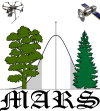Bryan Begay, Thomas Braun, Katie Nicolato || Oregon State University Cartography and Geovisualization Group
This geovisualization displays a coniferous forest stand in the McDonald-Dunn forest northwest of Corvallis, OR, USA. This stand is near the Lewisburg Saddle, a popular recreation area with hiking and mountain biking trails. The McDonald-Dunn is a research forest owned by Oregon State University.
We feature a 3D LiDAR point cloud (Light Detection and Ranging) overlaid onto a terrain map with a toolbar for manipulating the visualization. Several geovisualization tools communicate the stand features:
- Unmanned Aerial System video footage of the stand familiarizes the user with the environment
- A 3D LiDAR cloud enables 360-degree stand visualization, quantification and immersion
- A topographic terrain model orients the stand in context with Willamette Valley geography
This geovisualization serves both science communication and quantitative purposes. We designed the project template as an adaptable tool for future forest stand visualization.
Our project goal was to visualize a LiDAR point cloud of a forest stand with terrain elements. This project stems from research creating point cloud visualization models to ensure maximized forest aesthetics. Point clouds capture high detail stand structure. Managers can use these models to pre-visualize timber harvests by simulating specific tree removal. An important element for this visualization is terrain. Depending on the terrain and residual structure of the post-harvest stand, it is possible to occlude or hide a timber harvest to increase forest aesthetics. We were initially interested in integrating a forest point cloud with a viewshed analysis tool utilizing terrain. Our base goal was to overlay a point cloud on a 3D terrain map for web visualization. Future development could include a viewshed analysis tool. The project template is adaptable for future forest stand visualization.
System Architecture
We converted the LiDAR point cloud file into a web format using the Potree Converter tool.
Example Potree Conversion command:
PotreeConverter.exe assets/merge.las -o web --projection "+proj=utm +zone=10 +ellps=GRS80 +datum=NAD83 +units=m +no_defs" -o web -p index
We consequently projected the 3D forest stand onto a digital surface model provided by Cesium 3D World Terrain.
We used WebSlides to create a 4-slide visualization:
Slide 1 introduces the visualization and plays Unmanned Aerial System footage of the target forest stand.
Slide 2 describes the visualization background and context.
Slide 3 displays the complete 3D LiDAR visualization with a tool sidebar.
Slide 4 displays the credits.
Functions
This geovisualization serves both science communication and quantitative purposes. The 3D LiDAR model presents a novel web visualization method for geospatial data interpretation. The sidebar in the 3D viewer allows user manipulation and measurement of the point cloud and terrain model.
WebSlides creates a 4-slide visualization.
Google Fonts supplied the Titillium Web font.
An example of design code adjusting text box size, shadow, and color:
LiDAR point cloud files (.las) were acquired from the DOGAMI Lidar Viewer.
Developers acquired aerial video footage of the target forest stand with a DJI Phantom 4 Unmanned Aerial System.
Cesium, MeshLine, D3, GeoTIFF, i18next, jQuery-ui, jQuery, jsTree, Leaflet, OpenLayers3, Perfect-Scrollbar, Plasio, Potree, Proj4, Shapefile, Spectrum, three.js, tween
Potree Converter transforms the .las cloud file into a web-friendly format.
Potree Viewer renders the forested point cloud.
Cesium ion renders the terrain map.
GitHub hosts the visualization.
Bryan Begay, Forest Engineering, Resources and Management, Oregon State University
Thomas Braun, College of Earth, Ocean, and Atmospheric Sciences, Oregon State University
Katie Nicolato, Forest Engineering, Resources and Management, Oregon State University
Dr. Bo Zhao, GEOG 572 Geovisual Analytics Instructor, Oregon State University
Cartography and Geovisualization Group, Oregon State University
Aerial Information Systems Lab, Oregon State University
Management, Algorithms, and Remote Sensing Lab, Oregon State University
Oregon Lidar Consortium







